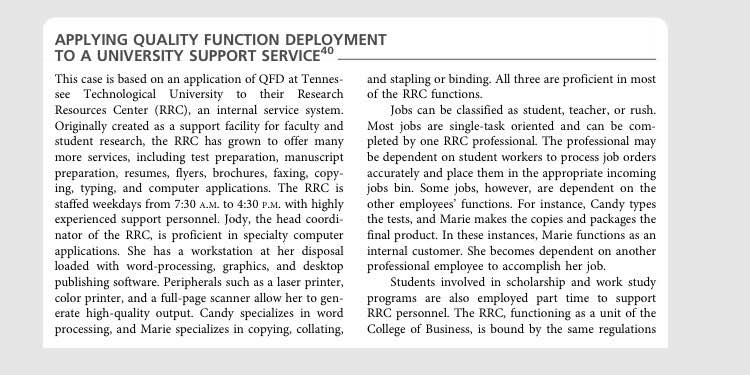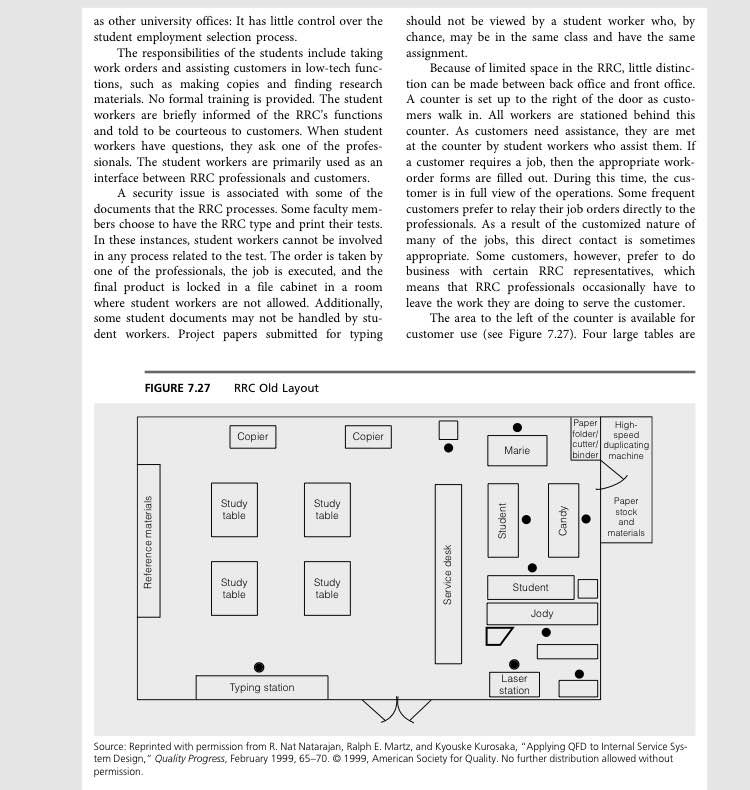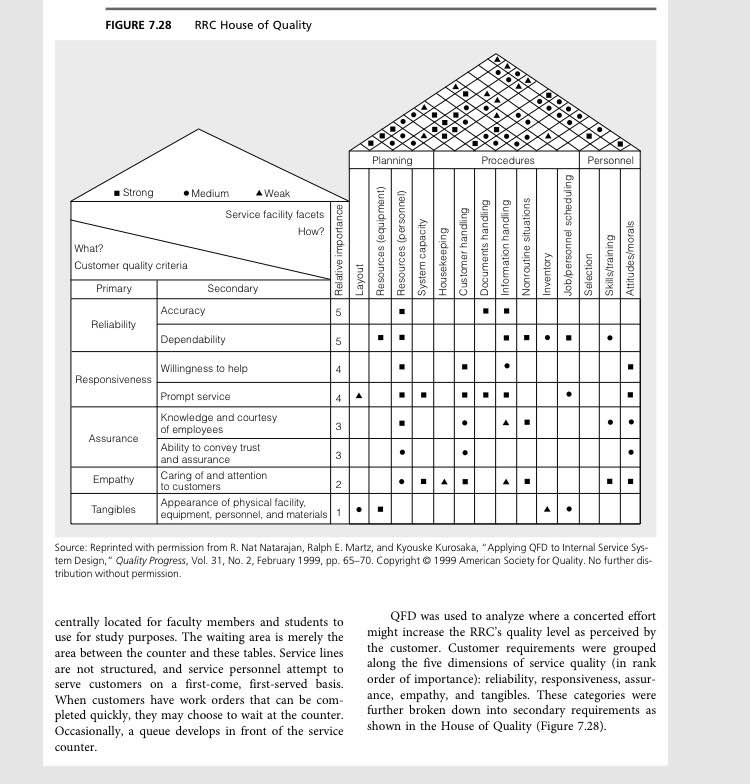Question
Read the case, Applying Quality Function Deployment to a University Support Service, page 366 and answer the questions at the end. 1. Do you agree
Read the case, Applying Quality Function Deployment to a University Support Service, page 366 and answer the questions at the end.
1. Do you agree with the "relative importance" of measures of the voice of the customer in Figure 7.28? The "relative importance" col. is the third col. from the left, containing numbers 1 through 5. Explain why these rankings are reasonable, or provide counter-arguments for a different ranking. For example, do you believe "appearance" should be the least important?
2. Using the relative importance ratings of the customer attributes and setting a scale of 1 = weak, 3 =medium, and 5 = strong for the relationship matrix, compute a weighted score for each of the technical requirements in Figure 7.28. For example, "layout" has a triangle (1 = weak) weighting for "prompt service", a circle (3 = medium) weighting for "tangibles", and no other relationships identified. So, the "layout" weighted score is calculated as (4 X 1 = 4) + (1 X 3 = 3) = 7. Calculate the other weighted scores. These weighted scores indicate what service components are most important. Do you agree with these relative weightings?
3. If your response to Question 1 above included recommended changes to the customer attribute ratings then how would those changes affect the calculations and conclusions in Question 2 above?
4. What other recommendations might you suggest based on the information provided in this case? Propose an improved layout of the RRC and justify your proposal.
***TEXT IN PHOTOS***



APPLYING QUALITY FUNCTION DEPLOYMENT TO A UNIVERSITY SUPPORT SERVICE40 This case is based on an application of QFD at Tennes- see Technological University to their Research Resources Center (RRC), an internal service system. Originally created as a support facility for faculty and student research, the RRC has grown to offer many more services, including test preparation, manuscript preparation, resumes, flyers, brochures, faxing, copy- ing, typing, and computer applications. The RRC is staffed weekdays from 7:30 A.M. to 4:30 P.M. with highly experienced support personnel. Jody, the head coordi- nator of the RRC, is proficient in specialty computer applications. She has a workstation at her disposal loaded with word-processing, graphics, and desktop publishing software. Peripherals such as a laser printer, color printer, and a full-page scanner allow her to gen- erate high-quality output. Candy specializes in word processing, and Marie specializes in copying, collating, and stapling or binding. All three are proficient in most of the RRC functions. Jobs can be classified as student, teacher, or rush. Most jobs are single-task oriented and can be com- pleted by one RRC professional. The professional may be dependent on student workers to process job orders accurately and place them in the appropriate incoming jobs bin. Some jobs, however, are dependent on the other employees' functions. For instance, Candy types the tests, and Marie makes the copies and packages the final product. In these instances, Marie functions as an internal customer. She becomes dependent on another professional employee to accomplish her job. Students involved in scholarship and work study programs are also employed part time to support RRC personnel. The RRC, functioning as a unit of the College of Business, is bound by the same regulations as other university offices: It has little control over the student employment selection process. The responsibilities of the students include taking work orders and assisting customers in low-tech func- tions, such as making copies and finding research materials. No formal training is provided. The student workers are briefly informed of the RRC's functions and told to be courteous to customers. When student workers have questions, they ask one of the profes- sionals. The student workers are primarily used as an interface between RRC professionals and customers. A security issue is associated with some of the documents that the RRC processes. Some faculty mem- bers choose to have the RRC type and print their tests. In these instances, student workers cannot be involved in any process related to the test. The order is taken by one of the professionals, the job is executed, and the final product is locked in a file cabinet in a room where student workers are not allowed. Additionally, some student documents may not be handled by stu- dent workers. Project papers submitted for typing FIGURE 7.27 Reference materials RRC Old Layout Copier Study table Study table Typing station Study table Study table Copier should not be viewed by a student worker who, by chance, may be in the same class and have the same assignment. Because of limited space in the RRC, little distinc- tion can be made between back office and front office. A counter is set up to the right of the door as custo- mers walk in. All workers are stationed behind this counter. As customers need assistance, they are met at the counter by student workers who assist them. If a customer requires a job, then the appropriate work- order forms are filled out. During this time, the cus- tomer is in full view of the operations. Some frequent customers prefer to relay their job orders directly to the professionals. As a result of the customized nature of many of the jobs, this direct contact is sometimes appropriate. Some customers, however, prefer to do business with certain RRC representatives, which means that RRC professionals occasionally have to leave the work they are doing to serve the customer. The area to the left of the counter is available for customer use (see Figure 7.27). Four large tables are Service desk Marie Student Student Laser station Jody Candy Paper High- folder/ speed cutter/ duplicating binder machine Paper stock and materials Source: Reprinted with permission from R. Nat Natarajan, Ralph E. Martz, and Kyouske Kurosaka, "Applying QFD to Internal Service Sys- tem Design, Quality Progress, February 1999, 65-70. 1999, American Society for Quality. No further distribution allowed without permission. FIGURE 7.28 RRC House of Quality Strong. What? Customer quality criteria Primary Reliability Responsiveness Assurance Empathy Tangibles Medium Weak Service facility facets How Accuracy Secondary Dependability Willingness to help Prompt service Knowledge and courtesy of employees Ability to convey trust and assurance Caring of and attention to customers Appearance of physical facility. equipment, personnel, and materials Relative importance Resources (equipment) Resources (personnel) System capacity Layout 5 4 * 3 3 2 Planning A centrally located for faculty members and students to use for study purposes. The waiting area is merely the area between the counter and these tables. Service lines are not structured, and service personnel attempt to serve customers on a first-come, first-served basis. When customers have work orders that can be com- pleted quickly, they may choose to wait at the counter. Occasionally, a queue develops in front of the service counter. I . L I . . " . Housekeeping Customer handling Documents handling Information handling Nonroutine situations Job/personnel scheduling Inventory Selection Skills/training Attitudes/morals . GOOD OOD Procedures . DO 4 . DOC . Personnel . . Source: Reprinted with permission from R. Nat Natarajan, Ralph E. Martz, and Kyouske Kurosaka, "Applying QFD to Internal Service Sys- tem Design," Quality Progress, Vol. 31, No. 2, February 1999, pp. 65-70. Copyright 1999 American Society for Quality. No further dis- tribution without permission. QFD was used to analyze where a concerted effort might increase the RRC's quality level as perceived by the customer. Customer requirements were grouped along the five dimensions of service quality (in rank order of importance): reliability, responsiveness, assur- ance, empathy, and tangibles. These categories were further broken down into secondary requirements as shown in the House of Quality (Figure 7.28).
Step by Step Solution
There are 3 Steps involved in it
Step: 1
Answer 1 Do you agree with the relative importance of measures of the voice of the customer in Figur...
Get Instant Access to Expert-Tailored Solutions
See step-by-step solutions with expert insights and AI powered tools for academic success
Step: 2

Step: 3

Ace Your Homework with AI
Get the answers you need in no time with our AI-driven, step-by-step assistance
Get Started


